Support Moonbow
Moonbow is a bi-monthly newsletter—with (mostly) free articles for you to enjoy. Your support allows me to pour time and love into these posts. If you enjoy Moonbow, please consider becoming a paid subscriber, forwarding this newsletter to a friend, or simply clicking the ‘like’ button.
With gratitude,
Taylor
Remember when I said I would share my ‘5 Things’ recommendations once a month? Welp, my last one was in April—sorry about that. There are a few good reasons for this. First, my life was turned upside down in June, and since then, I’ve been working on Moonbow sporadically from coffee shops, the library—and sometimes—at midnight, from bed. My hours are limited. Second, I’ve been writing quick and easy recommendations on the internet since 2008! Anyone who writes for online publications understands that writing listicles is a necessary evil. Moonbow is my antidote—it’s where I write for me, not a target audience. Not that there’s anything wrong with writing for an audience—it’s smart. It’s what I teach brands to do. But I spend so much time focusing on that for others that here, it’s nice to be freer, less methodical. Moonbow is where I explore, experiment, and (hopefully) grow as a writer and thinker, and thankfully, I have a supportive community that allows me that freedom. Third, in the past five months, it feels like everyone who is anyone on the internet has joined Substack, and they’re all sharing recommendations. I didn’t want to contribute to the noise. Still, it does say “Professional Recommender” on my Instagram bio—so I better get back to it before the Instagram police come after me.
As with all my “5 Things,” it’s not only five things. Names can be misleading.
The Puppets of Spelhorst, a Norendy Tale (#1)
written by Kate DiCamillo and illustrated by Julie Morstad (2023)
There are two books that fundamentally changed the way I think about picture books: People (2011) by Blexbolex and How To (2013) by Julie Morstad (which I wrote about in How To Fall In Love With a Picture Book). Both books are surprising and thought-provoking—they demand your attention. They’re also deceptively simple; the relationship between text and image is subtly complex. Reading these two children’s books was, as far as I can remember, the first time I felt jolted not by the story but by the design. I recognized the use of negative space, typography, color, and layout—and how these elements work together to create an expansive reading experience. It was thrilling. I’ve been hooked ever since.
Demanding a lot from readers is something the award-winning author Kate DiCamillo does in her books, too. Her novels for kids are often dark and complex; they don’t shy away from the tough realities of being a child, of being a human. When I found out she was writing a fairy tale novella, The Puppets of Spelhorst, with illustrations by Morstad, I was hyped. I couldn’t wait to see how these two innovative artists would team up to tell a story.
The illustrations in chapter books work differently than in picture books; they’re more decorative, but that doesn’t mean they don’t have a big impact on the story. The choices the illustrator makes are crucial to the reader’s experience. Reveal something too soon—or in a way that feels disingenuous—and they risk losing the reader. What’s shown and not shown can make or break a book. When done well, the illustrations in a chapter book are surprising delights that bring the fuzzy images in the reader’s mind to life. The key is to be both clear and subtle; it’s a delicate balance, but luckily, with Morstad, we’re in safe hands.
We’re safe with DiCamillo, too—who is a master storyteller. The Puppets of Spelhorst is an original fairy tale, the first in a trilogy. Even its place of origin, Norendy, is fictional. DiCamillo collects ideas for names like breadcrumbs—scavenging them from here and there—and then bakes them into something new and fresh, stuffed with delicious intrigue. Like India Opal Buloni in Because of Winn-Dixie (2000), Despereaux in The Tale of Despereaux (2003), and Flora Belle Buckman in Flora & Ulysses (2013). The word “Norendy” was inspired by “The Deluge at Norderney,” a story in Isak Dinesen’s Seven Gothic Tales (1934). In an interview for The Book Case podcast, DiCamillo explains that Norendy is “anywhere, everywhere, out of the corner of your eye, squint and you see it.”
The Puppets of Spelhorst is set in three acts, following the journey of five puppets: the king, a wolf, a girl, a boy, and an owl—united by an unknown destiny. Each of them is driven by desire and purpose; they believe they’re part of a bigger story, but it’s a mystery. Like any great story, there are layers of stories nestled within, each “linked by place and mood,” bound to one another by connection and circumstance. Throughout Spelhorst, the puppets experience disappointment and wonder, grief and joy, often simultaneously. Eventually, they end up in the home of two young sisters, Emma and Martha, who write a play for them to star in. Emma tells the audience it’s “a tale of truth and wonder and sorrow.” After the performance, the puppets are filled with a sense of purpose and pride—they’re part of a great story, but is it over, or has it just begun?
At the heart of Spelhorst, there are two underlying questions:
What is my story?
and
What happens if that story is different than the one I want to tell?
It’s the story of being human.
Book Merch
Unsurprisingly, authors and illustrators of children’s books tend to make the best-looking merch. But what is surprising is that most don’t. It’s such a lost marketing opportunity! Why wouldn’t you want walking billboards of your book? I recently found this vintage gem of Viola Swamp, one of the most memorable characters in children’s picture books. If you don’t know, she was in Miss Nelson Is Missing! (1977), Miss Nelson Is Back (1982), and Miss Nelson Has a Field Day (1985), written by Harry Allard and illustrated by James Marshall. It never gets old when someone yells at me from across the street, “YES! Viola Swamp!” and then gives me a thumbs up—a fleeting moment of solidarity between two superfans.
The creators behind “The First Cat in Space” graphic novel series, Mac Barnett and Shawn Harris, are smart about marketing—mostly because their merch is well-done, but also because it feels authentic—like they made it for themselves. Here’s my new favorite T-shirt from their recent tour for book two, The First Cat in Space and the Soup of Doom (2023).
The First Cat in Space and the Soup of Doom is the highly anticipated sequel to The First Cat in Space Ate Pizza, which I voted as one of The Best Children’s Books of 2022. For families (like mine) who’ve followed these books since they were live cartoons, they’re particularly special. Even if you have children who can read on their own, I recommend reading this book out loud to them—and it’s even better when you read it aloud to each other. I read it without any assistance from Mac and Shawn on the voices of the new characters (now you can hear them read it on audiobook), and I made a real fool of myself. Even Captain Baby Beard, a staple character from book one, went haywire—somehow, I made him sound like Ted from Bill & Ted’s Excellent Adventure (great movie) but with a horrible pirate accent. (I blame Dennis from book one.) Thankfully, it only added to an already hilarious and raucous reading experience.
In Soup of Doom, the Moon Queen is poisoned by soup, and it’s up to First Cat and Loz 4000 to save her. We meet hilarious new characters like a buff wizard whose girlfriend organizes his books by color (the horror!) and the whacky Dr. Lollipops, who has major Pee-wee Herman/Mr. Peanut vibes. It’s a bombastic, theatrical adventure with a standout cast.
Speaking of a raucous reading experience, we recently finished the latest in the Dory Fantasmagory chapter-book series, Can’t Live Without You. Reading the Dory books with my kids has been my favorite read-aloud experience! (This series also made my Best Children’s Books of 2022 list). These books make my children and I laugh so hard—and at the same things—which almost never happens. They’re also deeply familiar to kids and their parents. I love how Dory’s mom is kind and patient with Dory’s unruliness—until she isn’t.
In Can’t Live Without You, Dory’s mom decides she’s ready to go back to work after staying home for years to raise her kids. This freaks Dory out. She immediately feels separation anxiety and starts obsessively thinking about death, dying, and disappearing. When she overhears two teenage girls talking about Mozart, she learns for the first time that he’s dead. Mozart is dead?! But when Dory runs to tell her mom the news, she can’t find her—she’s lost! She eventually finds her mom, but the newfound realization that people die, or they leave and sometimes never come back, haunts Dory.
“Mom, if you die, I want to make a stuffed animal that looks just like you, so I can always look at you.”
“…That’s a very strange thing to say. But thank you.”
As in all the Dory books, Dory’s crazy constellation of imaginary friends come out to play. There’s Mary, a monster who lives under Dory’s bed (and likes to hang out on the toilet); Mr. Nuggy, her clumsy fairy godmother (whom she calls on a banana phone); and Mrs. Gobble Gracker, Dory’s longtime evil nemesis (who looks like the Wicked Witch of the West meets Dracula meets Viola Swamp).
Throughout the series, Dory deals with disappointments and anxieties that trouble most kids: learning how to read, peer pressure, family dynamics, and making new friends. Her worries are filtered through her wild imagination; reality and make-believe blend together. She processes her emotions and learns to navigate her experiences through imaginary play. Sometimes, this helps; sometimes, it gets her into trouble. Dory reminds me of Ramona Quimby, my favorite character in all of children’s literature. Both are energetic and inquisitive with fierce imaginations. Maybe you know a kid like that? Maybe you were that kid? Maybe you have that kid? Maybe all of the above! Whatever your experience, Dory Fantasmagory is a hilariously relatable series that’s fun for the whole family.
In the fifth book, Dory Fantasmagory: Tiny Tough (2019), there’s a funny reference to a Harry Allard and James Marshall book. Hanlon never reveals the actual book title, but fans of the book will know right away. See if you know it.
Did you guess The Stupids Die (1981), written by Harry Allard and illustrated by James Marshall? If so, you got it!
Dory’s right: It’s so funny!
There’s a lot of controversy over The Stupids books. Some with good reason, but mostly, it’s a matter of taste. Hanlon subtly references this by using the word “stupid” occasionally throughout the Dory books. In an interview for Vulture, Hanlon says that the people who react negatively to her books aren’t her people, and that’s okay. “If you met me, you would not like me, you would not like my kids, you would not like my parenting.” She goes on to say that there’s been some talk about changing the word “stupid” to “silly” in newer editions, but I hope that doesn’t happen. Kids use the word stupid. They always have, and they always will. It doesn't mean you have to condone it; instead, you can acknowledge that this is true and talk about it with your kids. And honestly, Hanlon is right. If you don’t like her use of the S-word, you probably won’t like the potty talk, throw-up, weird thoughts (like wanting to put one of your mom’s body parts in your locket), and talk of death. But in my house, that’s just an average Tuesday.
In case you missed it:
A couple of weeks ago, I shared an in-depth piece about Margaret Wise Brown and the Art of Paying Attention. This is another reason I haven’t posted as much. This piece took months and zapped me of brain power. During the process, I was reading, writing, and editing so much that I could barely speak in cohesive sentences by the end of the day. My brain turned to mush. Does that happen to any of you? Just me? Cool.
One of my favorite children’s booksellers, Kate Humphreys of Oly Oly Oly Oxen Free Books, shared 5 kids’ books that shaped her.
I was featured in one of my favorite newsletters, À La Carte, written by my friend and creative director, Ali LaBelle. If you want to know who my dream dinner date is and what ideal happiness looks, feels, tastes, and sounds like to me, head over to her Substack.
The Skull by Jon Klassen is one of the best books I’ve read this year! If not the best. I recently heard Jon describe The Skull, not as a scary book necessarily (although it is meant to be kind of scary), but as a love story—a love story about friendship. This is never explicitly said in the book. But that’s the power of picture books: a lot is said without actually saying it.
In case you’re wondering, Otilla from The Skull makes for an easy Halloween costume!






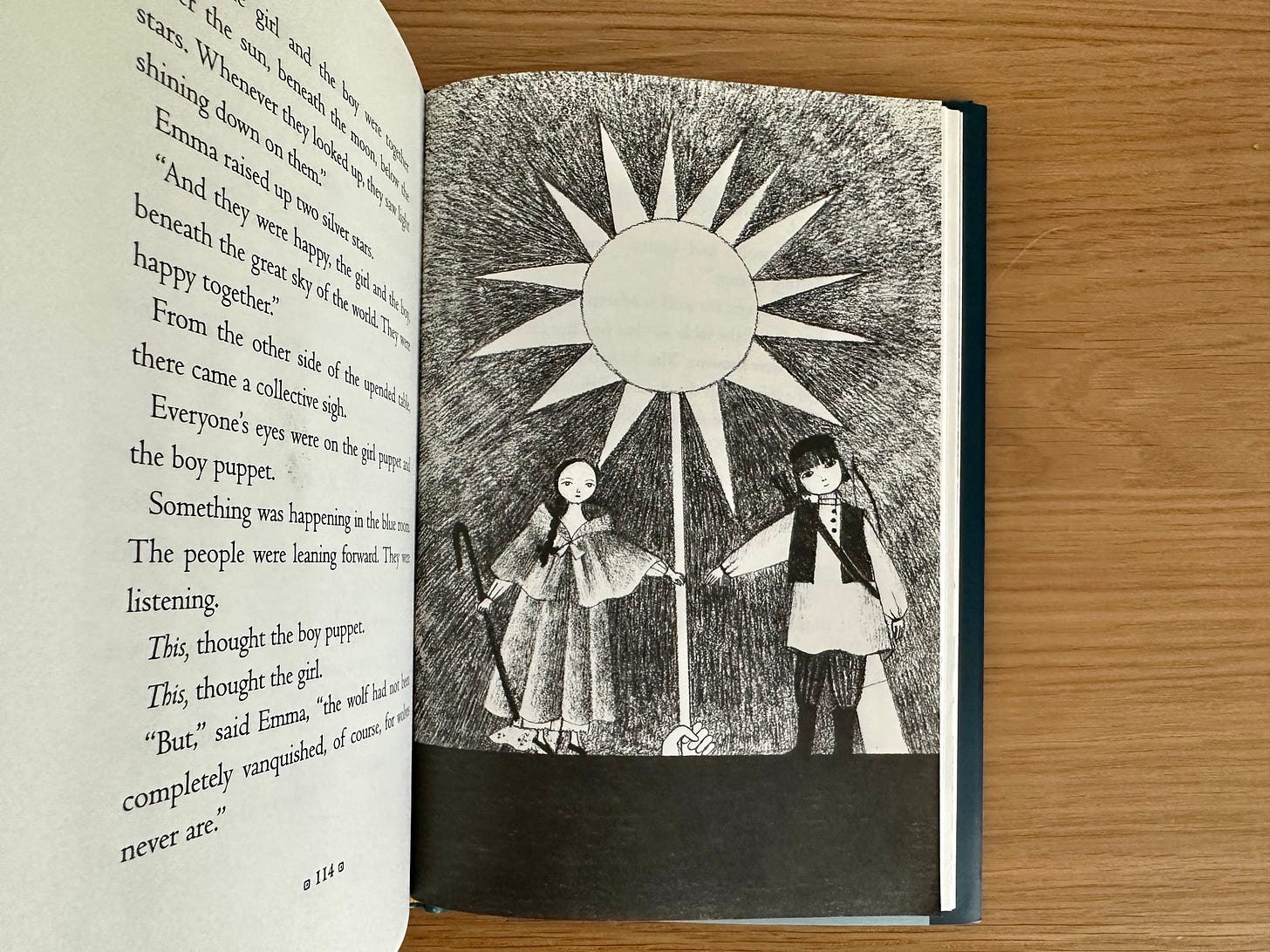

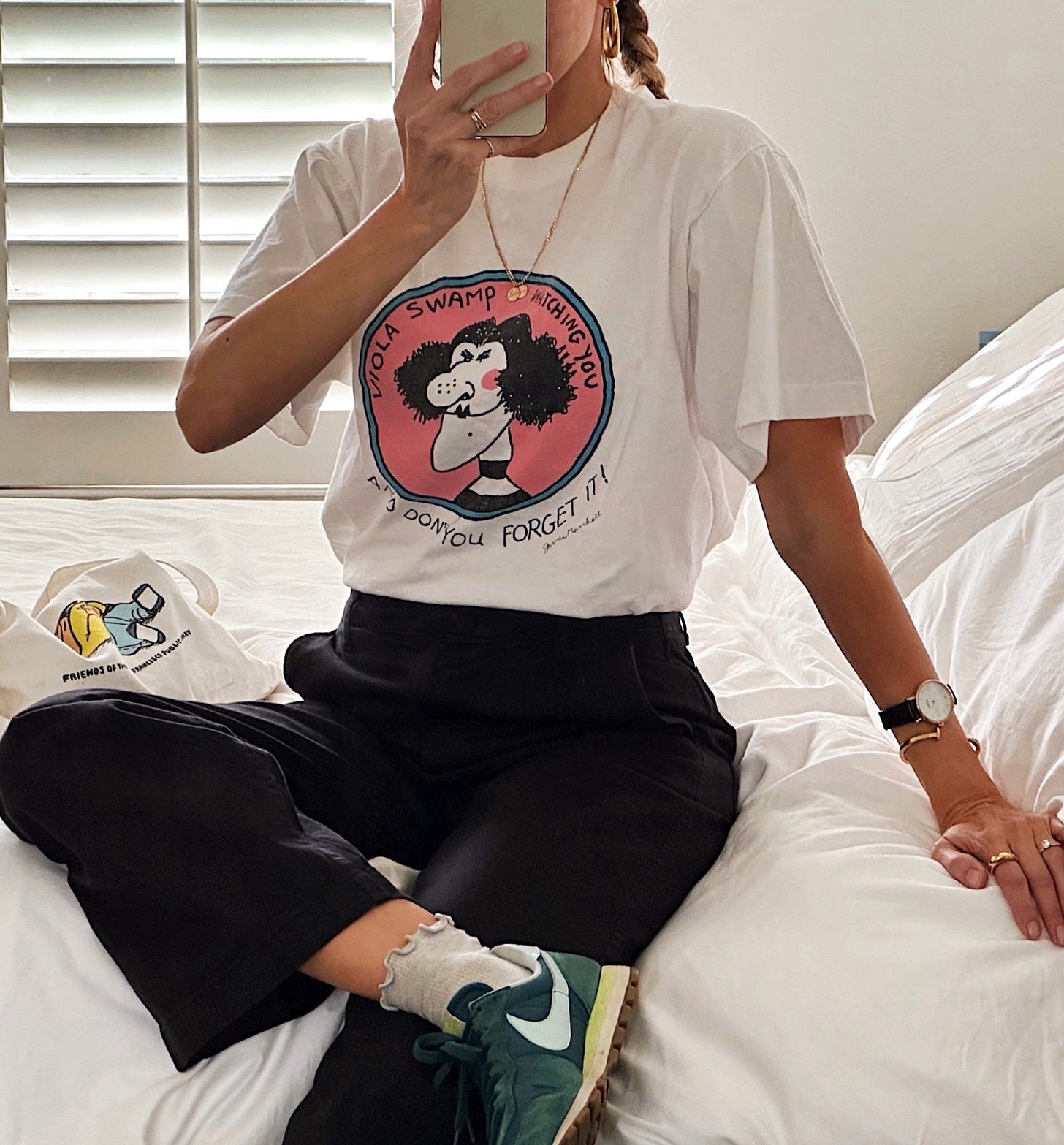

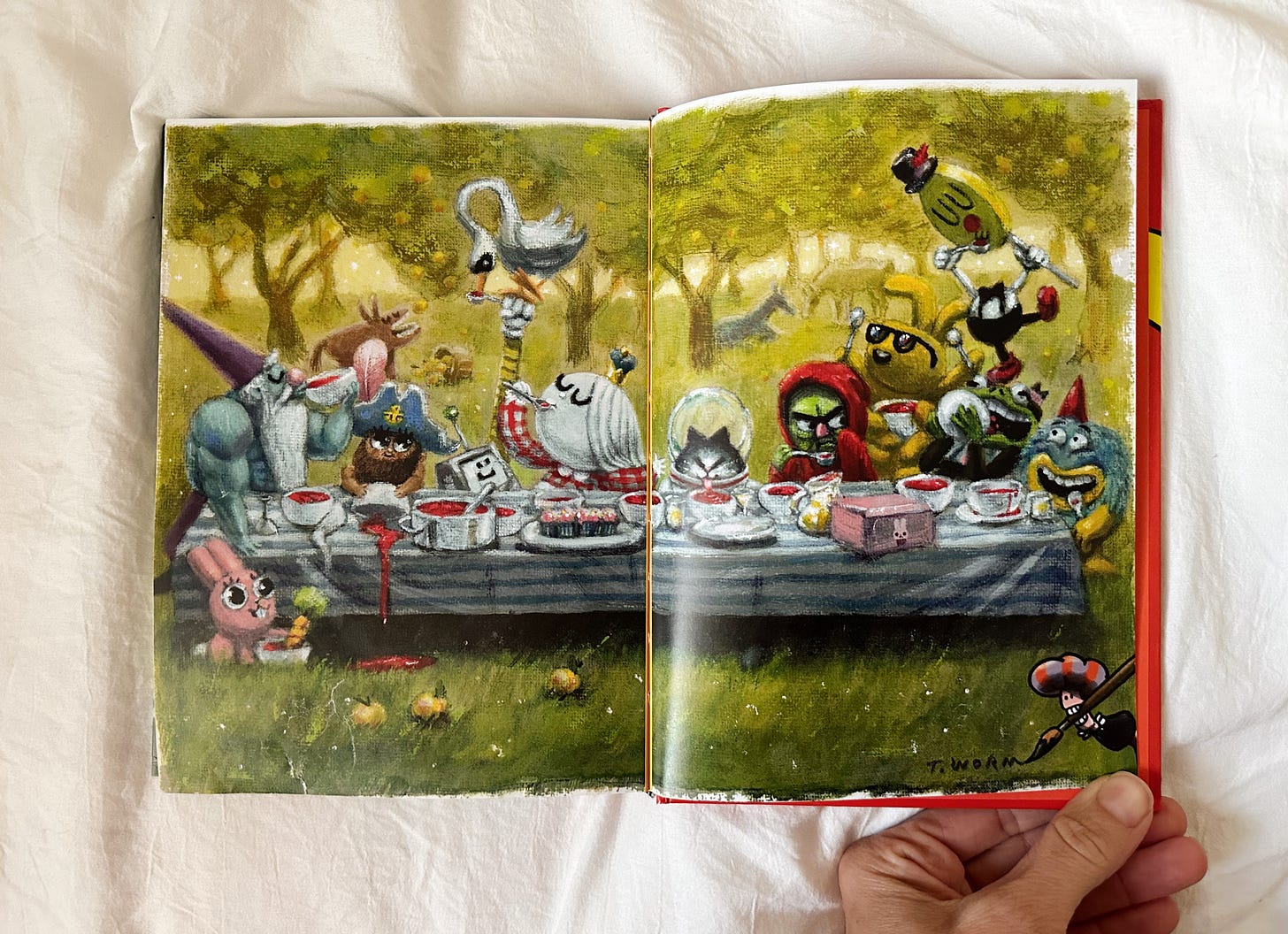
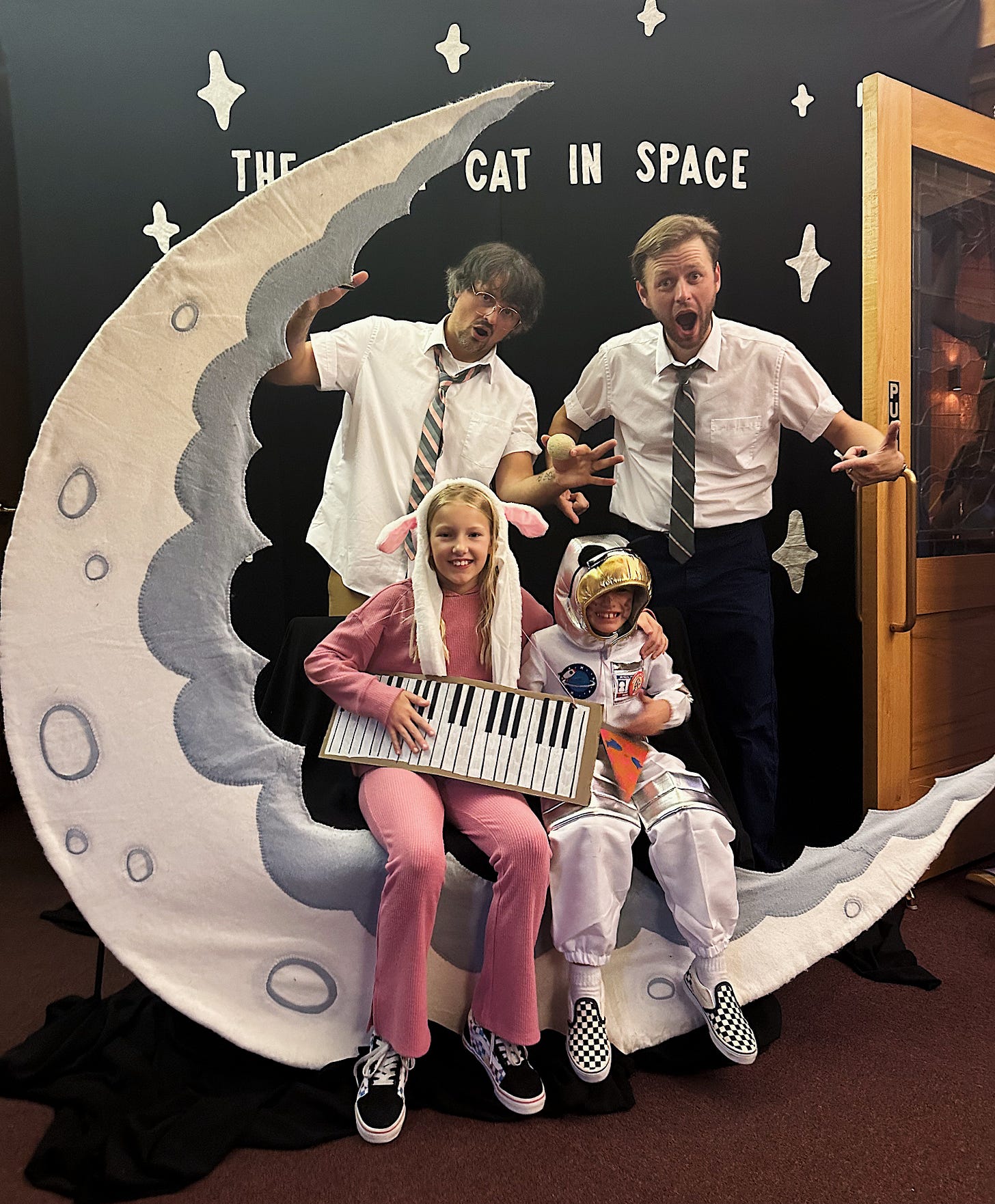
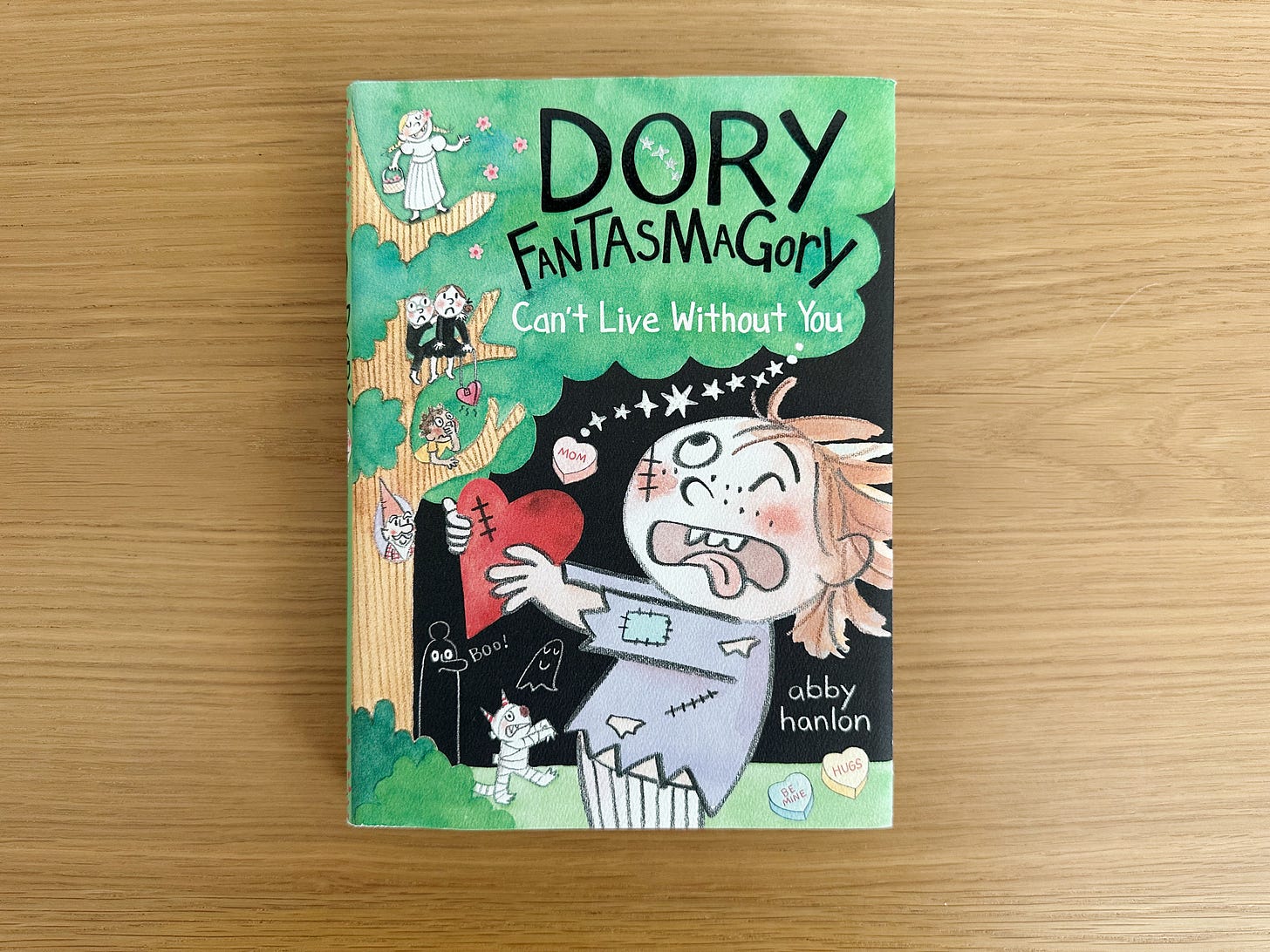
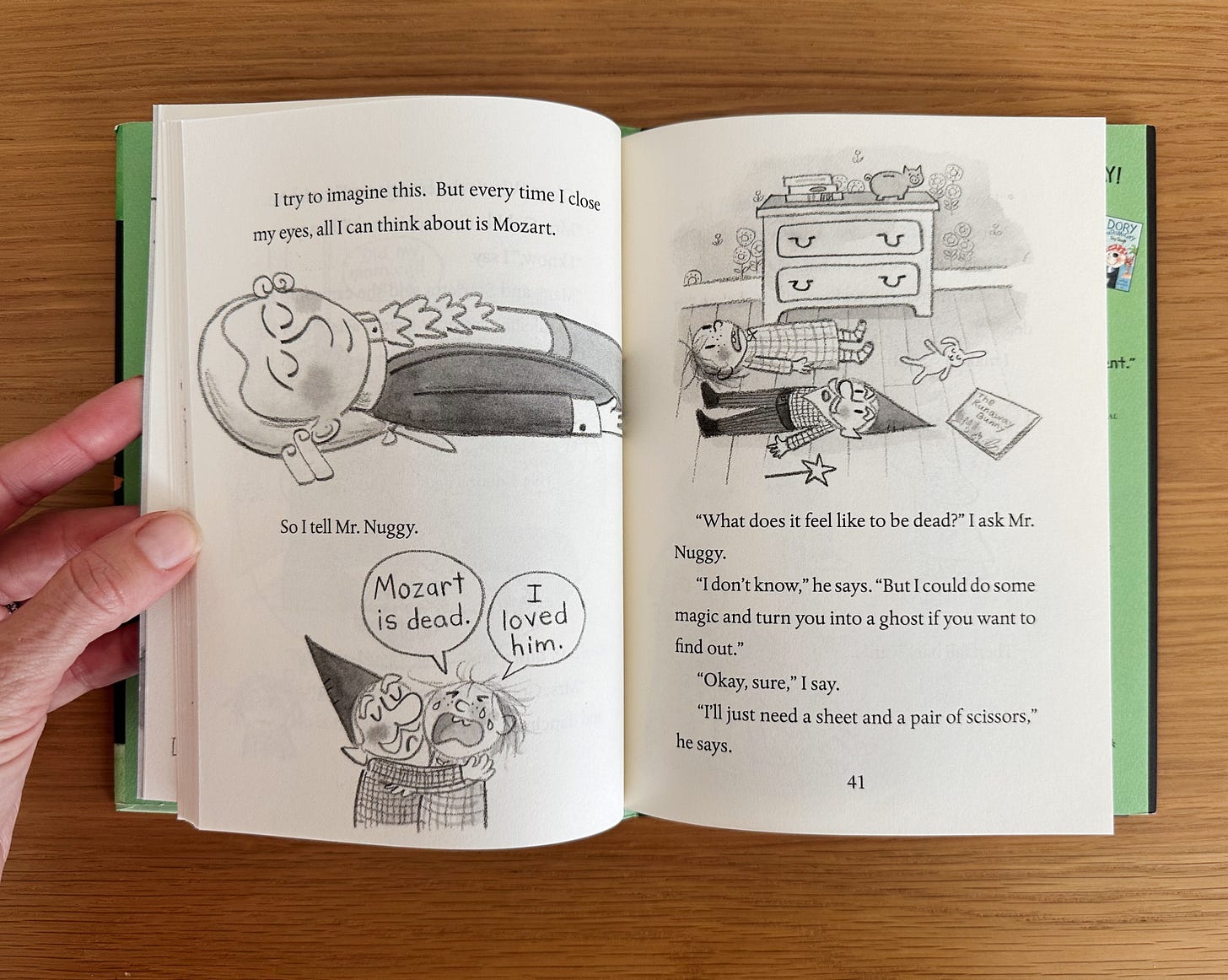






“YES! Viola Swamp!” Also: thanks for the Dory Fantasmagory recommendation. Adding that to my list!
1. The Viola Swamp shirt -- I almost fell out of my chair. I'm so envious!
2. The Ottila costume. You are the winner of Halloween.